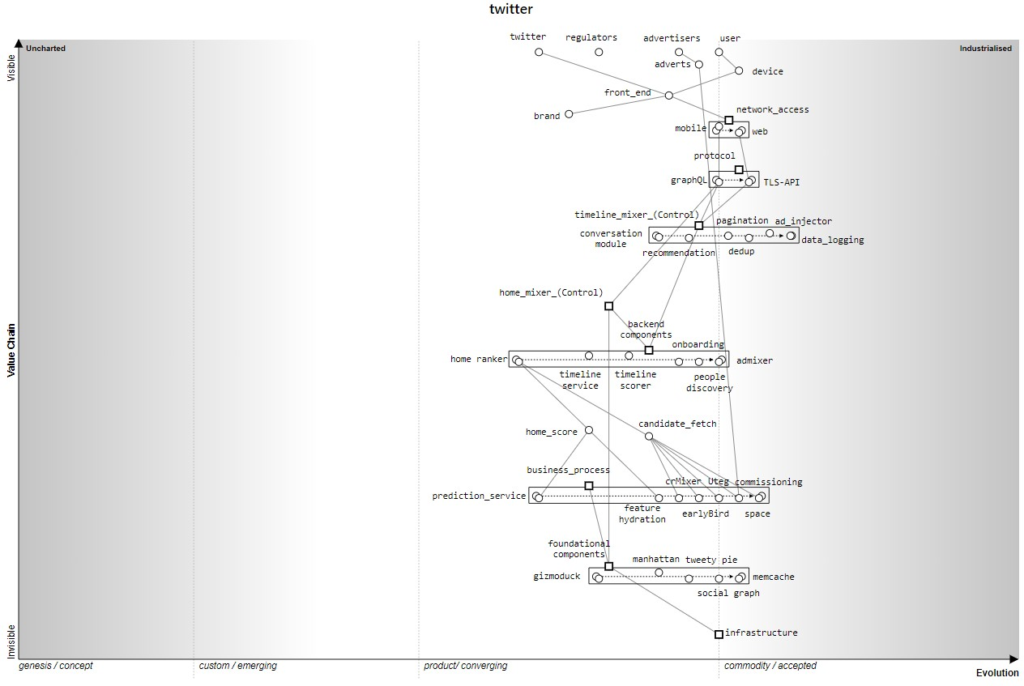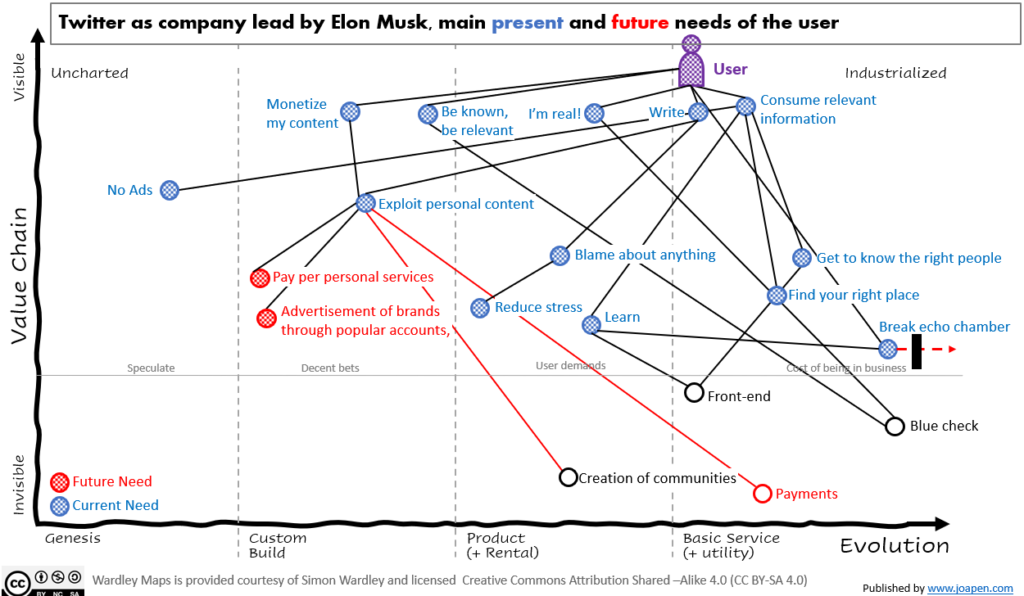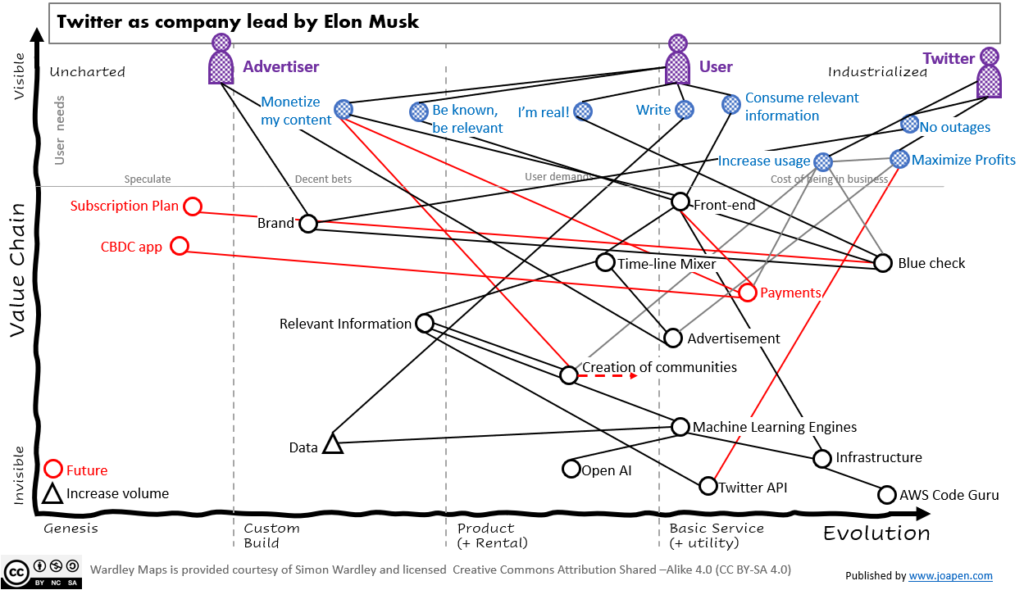John Grant challenge the Wardley Map community to use an architecture diagram shared by E. Musk. The challenge was to Map Twitter’s architecture diagram from different perspectives.

To me this is the second time I stop to think about this. In April, when rumors about the Twitter acquisition were spreading through the news, I did my first exercise. Retrospectively, I can tell you it was a naïve analysis, but I learned a lot.
Simon’s answer was really fast

Link to the map on On-line Wardley Maps.

My perspective was to focus on user needs: present and future needs.
The full conversation is on John’s tweet thread, but here I will focus on the output that resulted of the draft maps I shared and the feedback received.
Saying it, in case you have some constructive feedback or additional comment, let me know.
User needs map
I will start with the user needs, basically because are the main link to the anchor (the user) and this explains the reasons the second map is drawn in such way.
The user needs have been collected by mi own thoughts and the feedback of some users (thank you!! Chris , John Grant, Mark Craddock, Simon Wardley and others).
I start with the map, and below some comments about it:

I have added three actors on the map:
- The user: this is the anchor of the map, and its needs are the first place where the eyes of the reader should go.
- The advertiser: they are right now very relevant as they are the main source of revenue for Twitter. Even do of the number of advertisers that apparently are cancelling contracts, they are very relevant: “follow the money”.
- Twitter: with the purpose of showing their needs, and the tensions with the other actors.
Type of users
As proposed by Martin Watling, there are different type of users that we could classify as:
- Predominantly consumers of content (passive).
- Predominantly creators of content (active).
The ultimate goal of these users are different, and the positive tensions between them are important to keep at a healthy way, and avoid what happens to places as Facebook, where the paid content is much prioritized that the consumption of relevant content for the user.
Take time to walk through the lines (links) and identify these tensions, basically because with all the changes that are coming, they will change.
The user needs
Present and future needs:
The evolution of needs make that the identification of a need for an user as “present” or “future” is so difficult. By this reason the classification I have done is more than questionable. Sorry, I have not data about usage of the current functionality and competitive analysis of other social networks.
The main needs
- Consume relevant information: I think this is the main or the starting reason people join Twitter. I think that one of the main reasons people are still consuming information in Twitter is because the time-line is chronologically organized and you can find information in a natiral way (for sure, if you follow 10.000 people, it’s more difficult).
- Write: the second powerful need. People willing to say something to the world. It’s still so powerful, even do you are followed by just 20 people.
- I’m real: Once you are a notorious user, you will find that there are people creating fake users with your name, your pictures and trying to get people following them to capture attention and/or erode your reputation. Right now there are mechanism (automatic and manual validations) that try to solve this problem. By that reason, there’s a moment where the user claims to be “real” in some way on this digital world.
- Be known, be relevant: This is linked to “be real” and the reputation or status label we use if real life. This is special important for the active users. Authors with recognized authority have more probability for reaching their goals.
- Monetize content: Content creators with the aim of monetizing it, recognizes that the conversions they have are low. To facilitate the monetization of content is something with space for improvement. This could potentially attract more content creators to the network (I think that in this space Instagram is doing a great job).
Main map: Twitter as company lead by Elon Musk
I start with the map, then I add some comments:

Long-term view
- Simon says that crypto world is a new form of financial exclusion, feudalism and an attempt to undermine the state. For the long term, some people seem to vision that the final goal of Elon is to build an environment that uses blockchain technologies under a set of rules that enable him and Twitter to gain more % of power. By that reason “CBCD” has been added. The vehicle will probably be x.com, the firm that was created a while ago, but it’s parked.
- The shift of Twitter towards a WeChat model (WeChat has been described as China’s “app for everything”) is something that is shared by different people . Ironically this would be a great major notorious example of a Western company copying a Chinese company model, isn’t it?.
- On this post, I explain the battle about the 30% that Apple and Google charge to the transactions that are done through mobile apps. This is something to pay attention about how Twitter is going to be able to handle it.
Medium-term view
- Have “no-outages” seem to be a short term priority for Twitter, after laying out multiple amount of people. It’s probably soon to reach a conclusion about the correlation between the layoffs and a potential outage, but bias are there and they are difficult to avoid.
- Be profitable: Twitter is a public company, and while other social networks have demonstrated to be profitable, Twitter has not been able to demonstrate it. Some important things to consider:
- It’s a public company and the shareholders cannot be ignored forever.
- Twitter have been bought ($44B) through money given by others. They are waiting for a return.
- By that reason one of the main medium term goals is probably to make Twitter financially sustainable.
- In which way? We’ll see.
Things missing on the map
- I have not added anything about ethics, content moderation and other topics like this. Despite they are very important topics, they are a huge complex topic that will require a specific conversation. I have labeled the conversations as “relevant” to the user, whatever the end purpose of that user is.
- The same applies with the way of leading the changes in the Twitter organization. This would be subject for a wide discussion about what Elon and the new lead team are doing.
- I have not added or mentioned the perverse goals or ways to act of Twitter that some parts of Twitter community are commenting. To me, is useless. Maybe you think that I’m biased or ignoring an important signal. If so, I challenge you to add facts on it.
New threads of revenue
- Blue check was the first step to monetize the ecosystem in a different way. I expect that this type of monthly subscription plan evolves to satisfy different needs. Some comments here:
- Examples of subscriptions: don’t see advertisements, different types of “checks”.
- There are people that sees multiple subscription plans as a complicated mechanism and they see simplification as essential aspect of this type of feature. This has to be taken into account.
- Creation of communities: there are many people creating and sharing content on Twitter, and the major challenge for them is to monetize it. Here there is a wide space for improvement. I see that with the creation of the right capabilities, creators could stay in Twitter and offer the same content many of them are monetizing through services as SubStack.
- Payments: this service seem to be one key piece for many of the components of the map. For instance, the creation of private communities under payment that enable subscribers to access to that content directly via Twitter. Other example is “I want to pay for not having ads on my time line”. Payments can start easily with a bridge to an existing service, then they can build their own capabilities to remove some intermediaries. On this space there is already a war, so we cannot ignore the reaction of competitors.
- Twitter API: right now you can do a lot of things thanks to Twitter API. You start doing home made python code and publish automatic tweets, or you can build automation services and get money for users that are willing to have: thousand of followers, automatic tweets, ways to gain traction, etc. To me this capability is something that Twitter can use to increase their revenue: for instance: set a fee for major third parties that use the API to make revenue. This is the reason I have added a red line between the API and maximize profits.
Data traffic is increasing
By many reasons the data traffic is increasing, I’m curious about the reasons. What I can see from here is:
- There are people forecasting the death of Twitter in Twitter.
- There are people commenting about how to be reached in Mastodon in Twitter.
- There are people complaining about how Elon fired employees on Twitter.
- Mr Trump and other questionable users, that were banned, are back.
- And so on.
Interestingly, nobody is saying: I’m leaving Twitter, you can reach me on Facebook.
Do you want to continue the conversation?
If so, you can leave a comment here or on Twitter.